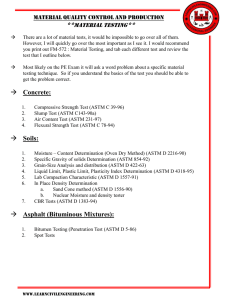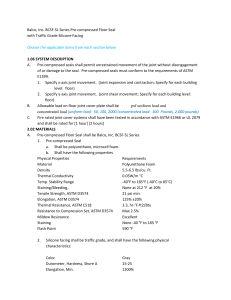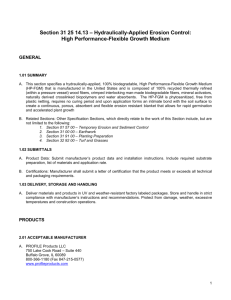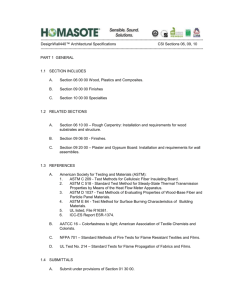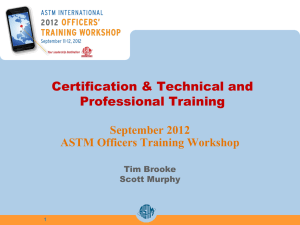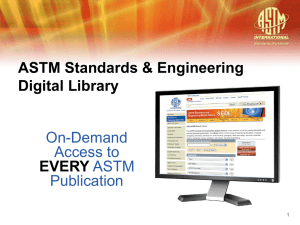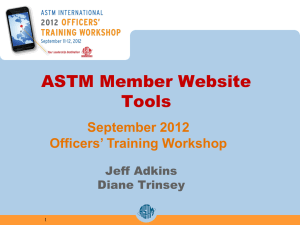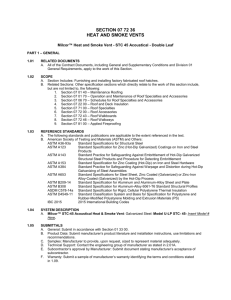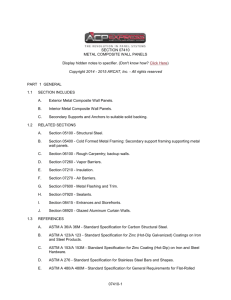Section 09800 - ACOUSTICAL TREATMENT
advertisement
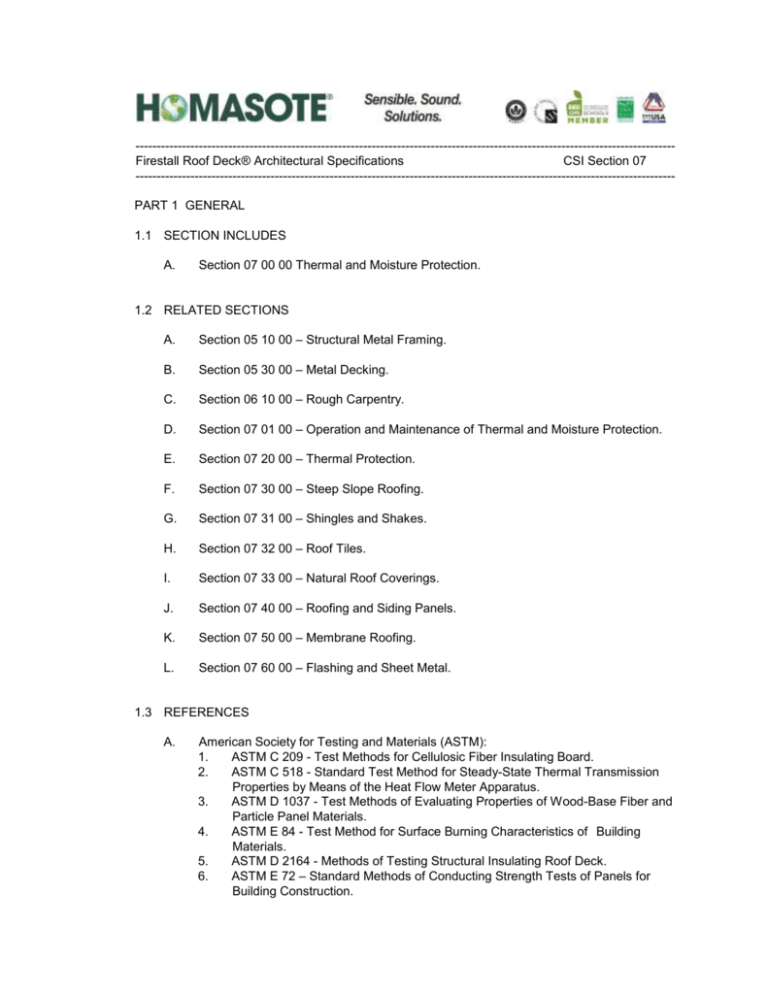
-------------------------------------------------------------------------------------------------------------------------------Firestall Roof Deck® Architectural Specifications CSI Section 07 -------------------------------------------------------------------------------------------------------------------------------PART 1 GENERAL 1.1 SECTION INCLUDES A. Section 07 00 00 Thermal and Moisture Protection. 1.2 RELATED SECTIONS A. Section 05 10 00 – Structural Metal Framing. B. Section 05 30 00 – Metal Decking. C. Section 06 10 00 – Rough Carpentry. D. Section 07 01 00 – Operation and Maintenance of Thermal and Moisture Protection. E. Section 07 20 00 – Thermal Protection. F. Section 07 30 00 – Steep Slope Roofing. G. Section 07 31 00 – Shingles and Shakes. H. Section 07 32 00 – Roof Tiles. I. Section 07 33 00 – Natural Roof Coverings. J. Section 07 40 00 – Roofing and Siding Panels. K. Section 07 50 00 – Membrane Roofing. L. Section 07 60 00 – Flashing and Sheet Metal. 1.3 REFERENCES A. American Society for Testing and Materials (ASTM): 1. ASTM C 209 - Test Methods for Cellulosic Fiber Insulating Board. 2. ASTM C 518 - Standard Test Method for Steady-State Thermal Transmission Properties by Means of the Heat Flow Meter Apparatus. 3. ASTM D 1037 - Test Methods of Evaluating Properties of Wood-Base Fiber and Particle Panel Materials. 4. ASTM E 84 - Test Method for Surface Burning Characteristics of Building Materials. 5. ASTM D 2164 - Methods of Testing Structural Insulating Roof Deck. 6. ASTM E 72 – Standard Methods of Conducting Strength Tests of Panels for Building Construction. 7. 8. 9. UL listed: TGIK.R16381. ASTM E 119 /UL 263 /NFPA 251, Fire Tests of Building Construction and Materials. UL1897 Wind Up-lift testing: UL-90 classification. 1.4 SUBMITTALS A. Submit under provisions of Section 01 30 00. B. Product Data: Manufacturer's data sheets on each product to be used, including: 1. Preparation instructions and recommendations. 2. Storage and handling requirements and recommendations. 3. Manufacturer’s installation instructions and methods. 1.5 QUALITY ASSURANCE A. Manufacturer Qualifications: Minimum 10 years experience in producing structural roof decking. B. UL1897 wind up-lift classification: UL-90. C. ASTM E 119 /UL 263 /NFPA 251, Fire Tests of Building Construction and Materials. 1.6 DELIVERY, STORAGE, AND HANDLING A. Store products in manufacturer's unopened packaging with labels intact until ready for installation. B. Inspect the materials upon delivery to assure that specified products have been received. Report damaged material immediately to the delivering carrier and note such damage on the carrier's freight bill of lading. C. Store materials in a dry place, indoors, on raised platform protected from weather damage. 1.7 PROJECT CONDITIONS A. Install panels to roof framing at delivery if possible to avoid double handling of material. Decking installation must be followed immediately with finish roofing. Any uncovered roof deck is to be covered with a waterproof tarpaulin to keep the deck dry from rain and nighttime condensation at the end of the workday. B. If Firestall panels do get wet from rain or nighttime condensation, then allow material to dry out completely before installing finish roof onto the deck. Under no circumstances install the finish roof over a wet roof deck. PART 2 PRODUCTS 2.1 MANUFACTURERS A. Acceptable Manufacturer: Homasote Company; 932 Lower Ferry Road, West Trenton, NJ 08628. Tel: (800) 257-9491. Tel: (609) 883-3300. Fax: (609) 883-3497. Email: sales@homasote.com; Website: www.homasote.com B. Requests for substitutions will be considered in accordance with provisions of Section 01 60 00. C. Substitutions: Not permitted. D. Provide all roof deck panels from a single manufacturer. 2.2 MATERIALS Description: Firestall Roof Deck is composed of two materials. The interior facing ply is composed of one layer of Class A, N.C.F.R. Homasote and the exterior facing is composed of one or more plies; depending on overall thickness, of 440 Homasote structural board. It is supplied in a 2’ x 8’ panel size with the tongue and groove on the 8’ edge. The 2’ is square edge. A. Exterior facing ply or plies: Class C fire-rated. Molded, recycled post-consumer paper, cellulose fiber structural panel made from 440 Homasote structural board. Physical properties as follows: 1. Thickness: ½” (13mm), 2’ x 8’ (610 x 2438 mm). 2. Density: 26-28 pcf (416-448 kg/cu. m) tested in accordance with ASTM C 209. 3. Tensile Strength: When tested in accordance with ASTM C 209: a. Parallel: 450-700 psi (3,100-4,830 kPa). b. Transverse: 750-1000 psi (5,1171-6,894 kPa). 4. Hardness (Janka Ball): 230 lbs (104 kg) tested in accordance with ASTM D 1037. 5. Water Absorption by Volume: When tested in accordance with ASTM C 209: a. 2 hour immersion: 7 percent maximum. 6. Expansion: 50 to 90 percent relative humidity, 0.25 percent in accordance with ASTM C 209. 7. Thermal Resistance: When tested in accordance with ASTM C 209 per ASTM C 518: a. R-value: 2.05 for 1”, 3.48 for 1 3/8” and 4.63 for 1 7/8” thick board. b. K-value: .512 Btu-in/ (h ft² °F). 8. Noise reduction coefficient (NRC): 0.20 9. Flame Spread: 76 to 200 tested in accordance with ASTM E 84, Class III or C. B. Interior facing ply: Class A fire-rated. Molded, recycled post-consumer paper, cellulose fiber structural panel made from N.C.F.R. Homasote structural board. Physical properties as follows: 1. Thickness: 1/2 inch (13 mm), 2’ x 8’ (610 x 2438 mm). 2. Density: 34-40 pcf (544-640 kg/cu. m) tested in accordance with ASTM C 209. 3. Tensile Strength: When tested in accordance with ASTM C 209: a. Parallel: 400-700 psi (2,755-4,830 kPa). b. Transverse: 600-900 psi (4,130-6,555 kPa). 4. 5. 6. 7. 8. C. Hardness (Janka Ball): 275 lbs (124 kg) tested in accordance with ASTM D 1037. Water Absorption by Volume: When tested in accordance with ASTM C 209: a. 2 hour immersion: 7 percent maximum. Expansion: 50 to 90 percent relative humidity, 0.30 percent in accordance with ASTM C 209. Thermal Resistance: When tested in accordance with ASTM C 209 per ASTM C 518: a. R-value: .85 for 1/2 inch (13 mm) thick board. b. K-value: .59 for 1/2 inch (13 mm) thick board. Class I or A. Flame spread 25, fuel contributed 0, smoke developed 20 as per ASTM E 84. Sizes and Weights: Thickness 1” 1 3/8” 1 7/8” Size 2’ X 8’ (23 1/8” X 95 7/8” NOM) Weight (lbs/sq.ft.) 2.62 3.48 4.63 R-value 2.05 2.5 3.1 All sizes are nominal. D. Load Table: Calculations are based on two or more continuous spans. Panel Thickness 1” 1 3/8” 1 7/8” Maximum Rafter Spacing for Live Loads of: 24” – 50PSF 32” – 50PSF 48” – 40PSF Spans are limited by 1/180 deflection expressed in lbs. per square foot of roof area projected on a horizontal plane and over two or more spans. 10 PSF dead load assumed. E. UL 1897 Wind Uplift: UL-90 Classification. 2.3 ACCESSORIES A. B. Roof Rafter Fasteners: 1. To wood framing: 16d annular thread type (ring shank) galvanized nail of sufficient length required to penetrate not less than 1 inch (305 mm) into framing. Coarse thread wood screws with 3/8” diameter flat heads of sufficient length required to penetrate not less than 1 inch (305 mm) into framing. 2. To metal framing: Consult installation instructions as to fasteners specified depending on type of metal framing used as well as gauge thickness. Finish Roofing Fasteners: 1. Nails for shingles, shakes and tiles: Annular threaded type (ring shank) galvanized nail of sufficient length required to penetrate not less than 1 inch (305 mm) into the deck. 2. Screws for shakes and tiles: #10 or #14 galvanized screws of sufficient length required to penetrate not less than 1 inch (305mm) into the deck. 3. Screws for standing seam metal roofing clips: #14 concealor screws of at least 1 ¼ inch (381 mm) in length. Clip spacing to be determined by installer and site environmental conditions. PART 3 EXECUTION 3.1 EXAMINATION A. Verify framing member spacing complies with manufacturer’s requirements. B. If framing installation is the responsibility of another installer, notify Architect of unsatisfactory preparation before proceeding. C. Verify what environmental conditions are, and will be in accordance with manufacturer’s recommendations. D. Starting work by installer is acceptance of framing and environmental conditions. 3.2 PREPARATION A. Bearing surface of roof framing is to be clean, level and parallel. B. Verify that the fasteners to be used are compatible with the type of rafter or purlin the deck is to be installed over. C. Report and correct defects before installation. 3.3 INSTALLATION A. Install in accordance with manufacturer's instructions. B. Install only clean dry panels. Do not install wet panels. C. Roof panel installation: Space panel joints (at the butt ends) 1/8 inch (3 mm) apart. Stagger joints. 3.4 PROTECTION A. Protect installed products from weather until completion of project. B. Repair, or replace damaged products before Substantial Completion.
